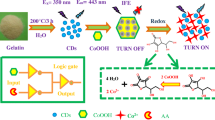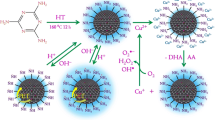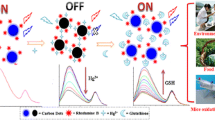Abstract
A novel amine-modified carbon quantum dots (NH2-CQDs), which can act as a dual-detection probe for the ascorbic acid (AA) response, was synthesized. The product was obtained via facile and green hydrothermal carbonization of L-histidine. The high nitrogen to carbon ratio of L-histidine warrants a high nitrogen content of these CQDs, and thus to have more free electron pairs. This results in good electron transport capability. The NH2-CQDs with an average diameter of 3.67 ± 0.78 nm display blue fluorescence, with excitation/emission maxima at 340/420 nm, and a quantum yield of 15.9%. The fluorescence can be quenched by AA. Moreover, the NH2-CQDs can selectively detect AA with electrochemical detection. On the basis of the electrochemical and fluorescent properties of the NH2-CQDs, the electrochemistry method and fluorescence analysis for the detection of AA with a detection limit of 2.7 μM and 57 nM are developed. This finding may provide a dual-detection platform, which can be used as a potential candidate for more selective to detect AA in pharmaceuticals, clinics, and food industries.

Schematic representation of the synthesis strategy of amine-modified carbon quantum dots (NH2-CQDs) and their electrochemical and fluorescent response to ascorbic acid (AA).








Similar content being viewed by others
References
Alwarappan S, Liu G, Li CZ (2010) Simultaneous detection of dopamine, ascorbic acid, and uric acid at electrochemically pretreated carbon nanotube biosensors. Nanomed-nanotechnol 6:52–57
Arrigoni O, De Tullio MC (2002) Ascorbic acid: much more than just an antioxidant. Biochimica Et Biophysica Acta-General Subj 1569:1–9
Atchudan R, Edison TNJI, Aseer KR, Perumal S, Karthik N, Lee YR (2017) Highly fluorescent nitrogen-doped carbon dots derived from Phyllanthus acidus utilized as a fluorescent probe for label-free selective detection of Fe3+ ions, live cell imaging and fluorescent ink. Biosens Bioelectron 99:303–311
Castelletti L, Piletsky SA, Turner AP, Righetti PG, Bossi A (2015) Development of an integrated capillary electrophoresis/sensor for L-ascorbic acid detection. Electrophoresis 23:209–214
Chen H, Li R, Lin L, Guo G, Lin J (2010) Determination of L-ascorbic acid in human serum by chemiluminescence based on hydrogen peroxide-sodium hydrogen carbonate-CdSe/CdS quantum dots system. Talanta 81:1688–1696
Chen S, Chi M, Yang Z, Gao M, Wang C, Lu X (2017) Carbon dots/Fe3O4 hybrid nanofibers as efficient peroxidase mimics for sensitive detection of H2O2 and ascorbic acid. Inorg Chem Front 4:1621–1627
Don P, Iuga A, Dacko A, Hardick K (2006) Treatment of vitiligo with broadband ultraviolet B and vitamins. Int J Dermatol 45:63–65
Dursun Z, Gelmez B (2010) Simultaneous determination of ascorbic acid, dopamine and uric acid at Pt nanoparticles decorated multiwall carbon nanotubes modified GCE. Electroanaly 22:1106–1114
Fong JFY, Chin SF, Ng SM (2016) A unique ‘turn-on’ fluorescence signalling strategy for highly specific detection of ascorbic acid using carbon dots as sensing probe. Biosens Bioelectron 85:844–852
Gao ZH, Lin ZZ, Chen XM, Zhong HP, Huang ZY (2016) A fluorescent probe based on N-doped carbon dots for highly sensitive detection of Hg2+ in aqueous solution. Anal Methods 8:2297–2304
Ghoreishi SM, Behpour M, Saeidinejad F (2012) Electrochemical determination of tryptophan, uric acid and ascorbic acid at a gold nanoparticles modified carbon paste electrode. Anal Methods 4:2447–2453
He X, Li H, Liu Y, Huang H, Kang Z, Lee ST (2011) Water soluble carbon nanoparticles: hydrothermal synthesis and excellent photoluminescence properties. Colloid Surface B 87:326–332
Khan MR, Alothman ZA, Naushad M, Ghfar AA, Wabaidur SM (2012) Simultaneous analysis of vitamin C and aspirin in aspirin C effervescent tablets by high performance liquid chromatography-photodiode array detector. J Liq Chromatogr R T 35:2454–2461
Kondo Y, Inai Y, Sato Y, Handa S, Ishigami A (2006) Senescence marker protein 30 functions as gluconolactonase in L-ascorbic acid biosynthesis, and its knockout mice are prone to scurvy. Proc Natl Acad Sci 103:5723–5728
Kong W, Wu D, Li G, Chen X, Gong P, Sun Z, Chen G, Xia L, You J, Wu Y (2017) A facile carbon dots based fluorescent probe for ultrasensitive detection of ascorbic acid in biological fluids via non-oxidation reduction strategy. Talanta 165:677–684
Kwon W, Lee G, Do S, Joo T, Rhee SW (2014) Size-controlled soft-template synthesis of carbon nanodots toward versatile photoactive materials. Small 10:506–513
Li H, He X, Liu Y, Huang H, Lian S, Lee ST, Kang Z (2011) One-step ultrasonic synthesis of water-soluble carbon nanoparticles with excellent photoluminescent properties. Carbon 49:605–609
Li L, Wang C, Luo J, Guo Q, Liu K, Liu K, Zhao W, Lin Y (2015) Fe3+-functionalized carbon quantum dots: a facile preparation strategy and detection for ascorbic acid in rat brain microdialysates. Talanta 144:1301–1307
Liu S, Tian J, Wang L, Zhang Y, Qin X, Luo Y, Asiri AM, Al-Youbi AO, Sun X (2012) Hydrothermal treatment of grass: a low-cost, green route to nitrogen-doped, carbon-rich, photoluminescent polymer nanodots as an effective fluorescent sensing platform for label-free detection of Cu (II) ions. Adv Mater 24:2037–2041
Liu JJ, Chen ZT, Tang DS, Wang YB, Kang LT, Yao JN (2015) Graphene quantum dots-based fluorescent probe for turn-on sensing of ascorbic acid. Sensor Actuat B-Chem 212:214–219
Liu J, Chen Y, Wang W, Feng J, Liang M, Ma S, Chen X (2016) Switch-on fluorescent sensing of ascorbic acid in food samples based on carbon quantum dots-MnO2 probe. J Agric Food Chem 64:371–380
Mariangela L, Vittorio B, Claudia LB, Leonardo F (2006) Preparation and characterization of aminated carbon from a single-step reaction. Chem Mater 18:4130–4136
Matsuoka Y, Yamato M, Yamada KI (2016) Fluorescence probe for the convenient and sensitive detection of ascorbic acid. J Clin Biochem Nutr 58:16–22
Miura T, Urano Y, Tanaka K, Nagano T, Ohkubo K, Fukuzumi S (2003) Rational design principle for modulating fluorescence properties of fluorescein-based probes by photoinduced electron transfer. J Am Chem Soc 125:8666–8671
Moretti M, Colla A, Balen GDO, dos Santos DB, Budni J, de Freitas AE, Farina M, Severo Rodrigues AL (2012) Ascorbic acid treatment, similarly to fluoxetine, reverses depressive-like behavior and brain oxidative damage induced by chronic unpredictable stress. J Psychiatr Res 46:331–340
Peng H, Travas-Sejdic J (2009) Simple aqueous solution route to luminescent carbogenic dots from carbohydrates. Chem Mater 21:5563–5565
Qin J, Nan Q, Yang J, Yang R (2018) Bright carbon dots via inner filter effect for the sensitive determination of the purine metabolic disorder in human fluids. Spectrochim Acta A 203:421–427
Roberts BM, Fullerton DR, Elliott SL (2015) High concentrations of L-ascorbic acid (vitamin C) induces apoptosis in a human cervical cancer cell line (HeLa) through the intrinsic and extrinsic pathways. Bios 86:134–143
Roy PR, Okajima T, Ohsaka T (2004) Simultaneous electrochemical detection of uric acid and ascorbic acid at a poly(N,N-dimethylaniline) film-coated GC electrode. Electroanal Chem 561:75–82
Shakya R, Navarre DA (2006) Rapid screening of ascorbic acid, glycoalkaloids, and phenolics in potato using high-performance liquid chromatography. J Agric Food Chem 54:5253–5260
Sood SP, Sartori LE, Wittmer DP, Haney WG (1976) High-pressure liquid chromatographic determination of ascorbic acid in selected foods and multivitamin products. Anal Chem 48:796–798
Sun CL, Lee HH, Yang JM, Wu CC (2011) The simultaneous electrochemical detection of ascorbic acid, dopamine, and uric acid using graphene/size-selected Pt nanocomposites. Biosens Bioelectron 26:3450–3455
Sun X, Brückner C, Nieh MP, Lei Y (2014) A fluorescent polymer film with self-assembled three-dimensionally ordered nanopores: preparation, characterization and its application for explosives detection. J Mater Chem A 2:14613–14621
Wang Y, Hu A (2014) Carbon quantum dots: synthesis, properties and applications. J Mater Chem C 2:6921–6939
Wang Z, Liu J, Liang Q, Wang Y, Luo G (2002) Carbon nanotube-modified electrodes for the simultaneous determination of dopamine and ascorbic acid. Analyst 127:653–658
Wang H, Maiyalagan T, Wang X (2012a) Review on recent progress in nitrogen-doped graphene: synthesis, characterization, and its potential applications. ACS Catal 2:781–794
Wang X, Wu P, Hou X, Lv Y (2012b) An ascorbic acid sensor based on protein-modified Au nanoclusters. Analyst 138:229–233
Xu H, Xiao J, Yan L, Zhu L, Liu B (2016) An electrochemical sensor for selective detection of dopamine based on nickel tetrasulfonated phthalocyanine functionalized nitrogen-doped graphene nanocomposites. J Electroanal Chem 779:92–98
Xu YL, Niu XY, Chen HL, Zhao SG, Chen XG (2017) Switch-on fluorescence sensor for ascorbic acid detection based on MoS2 quantum dots-MnO2 nanosheets system and its application in fruit samples. Chin Chem Lett 28:338–344
Yang L, Huang N, Lu Q, Liu M, Li H, Zhang Y, Yao S (2016) A quadruplet electrochemical platform for ultrasensitive and simultaneous detection of ascorbic acid, dopamine, uric acid and acetaminophen based on a ferrocene derivative functional Au NPs/carbon dots nanocomposite and graphene. Anal Chim Acta 903:69–80
Yang H, Li F, Zou C, Huang Q, Chen D (2017) Sulfur-doped carbon quantum dots and derived 3D carbon nanoflowers are effective visible to near infrared fluorescent probes for hydrogen peroxide. Microchim Acta 184:2055–2062
Zhang H, Wang Y, Wang D, Li Y, Liu X, Liu P, Yang H, An T, Tang Z, Zhao H (2015) Hydrothermal transformation of dried grass into graphitic carbon-based high performance electrocatalyst for oxygen reduction reaction. Small 10:3371–3378
Zhang H, Kang S, Wang G, Zhang Y, Zhao H (2016) Fluorescence determination of nitrite in water using prawn-shell derived nitrogen-doped carbon nanodots as fluorophores. ACS Sensors 1:875–881
Funding
This work was supported by the National Natural Science Foundation of China (Nos. 51661033, 51361028, 51161025, and 31660538).
Author information
Authors and Affiliations
Corresponding author
Ethics declarations
Conflict of interest
The authors declare that they have no conflict of interest.
Additional information
Publisher’s note
Springer Nature remains neutral with regard to jurisdictional claims in published maps and institutional affiliations.
Highlights
• NH2-CQDs were synthesized by the green hydrothermal treatment of l-histidine and NaOH.
• The NH2-CQDs possess good electronic transmission capability and fluorescence performance.
• The obtained NH2-CQDs were used for dual-detection sensing platforms.
• The strategy has wider linear range and lower detection limit for ascorbic acid detection.
Electronic supplementary material
ESM 1
(DOCX 985 kb)
Rights and permissions
About this article
Cite this article
Zhou, X., Qu, Q., Wang, L. et al. Nitrogen dozen carbon quantum dots as one dual function sensing platform for electrochemical and fluorescent detecting ascorbic acid. J Nanopart Res 22, 20 (2020). https://doi.org/10.1007/s11051-019-4741-9
Received:
Accepted:
Published:
DOI: https://doi.org/10.1007/s11051-019-4741-9




